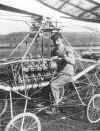 n
late 1906, the Wrights seemed to make some progress in selling their
airplane. Charles Flint, a highly successful New York dealmaker, heard of
their invention through a former employee. He invited them to meet with
him when they visited New York in December to attend the Aero Club of
America exhibition. They met, and Flint explained he would like to sell
the Wright airplane abroad, especially in Europe. After several follow-up
meetings in both New York and Dayton, Flint and the Wrights arrived at a
tentative agreement. Flint fired up his sales force in Britain, France,
and Germany. n
late 1906, the Wrights seemed to make some progress in selling their
airplane. Charles Flint, a highly successful New York dealmaker, heard of
their invention through a former employee. He invited them to meet with
him when they visited New York in December to attend the Aero Club of
America exhibition. They met, and Flint explained he would like to sell
the Wright airplane abroad, especially in Europe. After several follow-up
meetings in both New York and Dayton, Flint and the Wrights arrived at a
tentative agreement. Flint fired up his sales force in Britain, France,
and Germany.
Meanwhile, the Aero Club president, Courtland Bishop, mentioned the
Wright's invention and their problems with the U.S. government to his
brother-in-law, Congressman Herbert Parsons. Parsons took the matter to
President Theodore Roosevelt. Roosevelt recommended to Secretary of War
Howard Taft that he investigate the Wright's invention. Taft sent a
directive to the Board of Ordinance, and the Secretary of the Board wrote
the Wrights requesting more information. Orville sent the information
promptly and on May 22, 1907, the secretary invited the Wrights to submit
a proposal to provide an aircraft and flight instruction to the United
States Army. Encouraged, the Wrights prepared a proposal and began to
build several aircraft with two seats, a powerful new motor, and improved
controls that they would use for demonstration flights. The Board of
Ordinance, unfortunately, did not respond with the same enthusiasm.
Although the door had been opened for the Wrights, talks dragged on.
At the same time, Flint's agent in Europe, Hart O. Berg, requested that
one of the Wright brothers travel to Europe to meet with potential buyers.
Wilbur met him in London in late May, and Berg explained that at present,
neither Great Britain nor Germany were interested in purchasing flying
machines from two American bicycle makers. The situation in France,
however, was more promising. The French were familiar with the Wright's
work, and Berg had opened talks to form a syndicate to manufacture Wright
airplanes in France. But the project soon bogged down in politics.
|
Click
on a photo to enlarge it.

In 1907, Santos Dumont took the design for his 14-bis
and turned it around, making a tractor biplane called the 15 bis. It
failed to fly.
|
|
Slow mails, cryptic telegrams, and newspaper gossip made Orville tense
and nervous. What was happening Europe? He resolved to go, as soon as he
finished one new aircraft. In mid-July, he crated up the new airplane �
the first Wright Model A � and he and the aircraft left for France.
Charley Taylor went too, to help Orville put the aircraft together and to
serve as the Wright's flight mechanic while they were in Europe.
It wasn't to be. Once Orville was reunited with Wilbur in Europe, he
could see for himself how hopelessly ensnared their business plans had
become in bureaucracy and political intrigue. The situation brightened
briefly in Germany � they actually made some headway in forming a German
syndicate � but the negotiations stalled, as they had in France. The
brothers concluded that to sell airplanes in Europe, they would have to
make demonstration flights and peddle them to anyone who had cash in hand.
To do that, they would need a stock of airplanes. They decided to go back
to Dayton, finish the planes they had begun, and come back to Europe to
fly in the spring. On November 11, Wilbur and Charley Taylor left for
home. Orville stayed a few more weeks to tie up loose ends and to line up
some suppliers of materials they would need, then he too sailed for
Dayton.
Despite the fact that they hadn't sold an airplane or established an
airplane business, the Wrights' visit to Europe had an important effect.
While in France, they met and became friends with Lieutenant Frank Lahm,
who had recently been asked to join the new aeronautical section of the
United States Army Signal Corps. Lahm wrote a letter to his commander,
Brigadier General James Allen stating that it was "�unfortunate
that this American invention, which unquestionably has military value,
should not first be acquired by the United States Army." The letter
had the desired effect. It moved the Army to put pressure on the Board of
Ordinance to hurry things along. They sent a letter to the Wrights in
Europe requesting a meeting. When Wilbur docked, he caught a train for
Washington, D.C. |

Wilbur greets Charlie Taylor in France in 1907.

As the Wright brothers were returning to America, an
important aviation first occurred in France that went little noticed. Paul
Cornu ascended vertically to a height of five feet in this strange machine
and hovered there for a full minute. It was the first successful
helicopter flight.
|